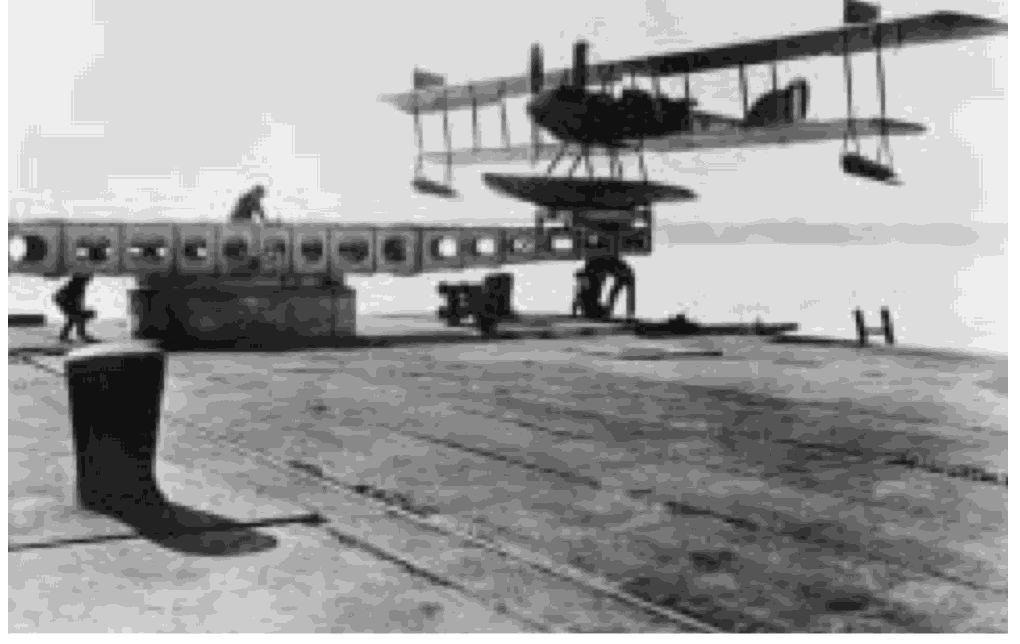
48
UNITED STATES NAVAL AVIATION
1910-1995
1920-Contin ued
27 March
A successful test of the Sperry gyrostabi-
lized automatic pilot system in an F-5L was completed
at Hampton Roads, Va.
2 April
NAS Hampton Roads, Va., reported that suc-
cessful night weather soundings had been made since
January, using candlelighted free balloons to measure
the force and direction of the wind.
1 May
Developmental and experimental work in
metal construction for aircraft was disclosed in a
Bureau of Construction and Repair report. Twelve
German Fokker D- VII planes, which used welded
steel extensively, were to be obtained from the Army
and two sets of metal wings for the HS-3 flying boat
were being procured from Charles Ward Hall.
18 June
A reversible pitch propeller designed by
Seth Hart and manufactured by the Engineering
Division, Army Air Service, was installed on the C-lO
airship at Rockaway Beach. That same month a Hart
reversible pitch propeller was ordered for the VE-7.
22 June
The Bureau of Navigation announced plans
to select four officers for a two-year postgraduate
course in aeronautical engineering at the Naval
Academy and M.LT., and asked for volunteers for the
fall semester. Part of the requirement was that
appointees take flight instruction and qualify as Naval
Aviatiors after completing their studies.
28 June
Six F-5Ls of the Atlantic Fleet Airboat
Squadron, commanded by Lieutenant Commander
Bruce G. Leighton, returned to Philadelphia, Pa., com-
pleting a seven-month cruise through the West Indies
on which the squadron logged 12,731 nautical miles,
including 4,000 flown on maneuvers with the fleet.
6 July
In a test of the radio compass as an aid to
navigation, an F-5L left Hampton Roads, Va., and flew
directly to
Ohio
(BB 12), 94 miles at sea in a position
unknown to the pilot. Without landing, the plane
made the return trip to Hampton Roads, Va., this time
navigating by signals from Norfolk, Va.
12 July
A general order provided for the organiza-
tion of the naval forces afloat into the Atlantic, Pacific
and Asiatic Fleets; and for the formation of type forces
within each designated Battleship, Cruiser, Destroyer,
Submarine, Mine, Air and Train. Under this order, the
Air Detachments in each fleet became Air Forces.
17 July
The Secretary prescribed standard nomen-
clature for types and classes of naval vessels, including
aircraft, in which lighter-than-air craft were identified
by the type "Z" and heavier-than-air craft by "V". Class
letters assigned within the Z type were R, Nand K for
rigid dirigibles, non-rigid dirigibles and kite balloons
respectively, while F, 0, S, P, T and G were estab-
lished for fighter, observation, scouting, patrol, torpe-
do and bombing and Fleet planes as classes within the
V type.
17 September
The site of the naval aviation activi-
ties on Ford Island was officially designated NAS Pearl
Harbor,
T.H.
4 November
The third of a series of tests to deter-
mine the effectiveness of aerial bombs against ships
was completed, using the old battleship
Indiana
(Battleship No.1) as a target. The tests which began
on 14 October were conducted at Tangier Sound in
the Chesapeake Bay under carefully controlled condi-
tions to determine both the accuracy with which
bombs could be dropped on stationary targets and the
damage caused by near-misses and direct hits.
1921
20
January
The Secretary of the Navy approved a
recommendation that development of radio-controlled
aircraft be undertaken by the Bureau of Ordnance and
the Bureau of Engineering.
20 January
A Naval Aircraft Factory design of a
turntable catapult, powered by compressed air, was
approved by the Bureau of Construction and Repair
for fabrication at the Philadelphia Navy Yard, Pa.
Aircraft were launched from capital ships by turntable catapult,
shown
on
a pier at NAF with an N-9 428435
 |
2 |
 |